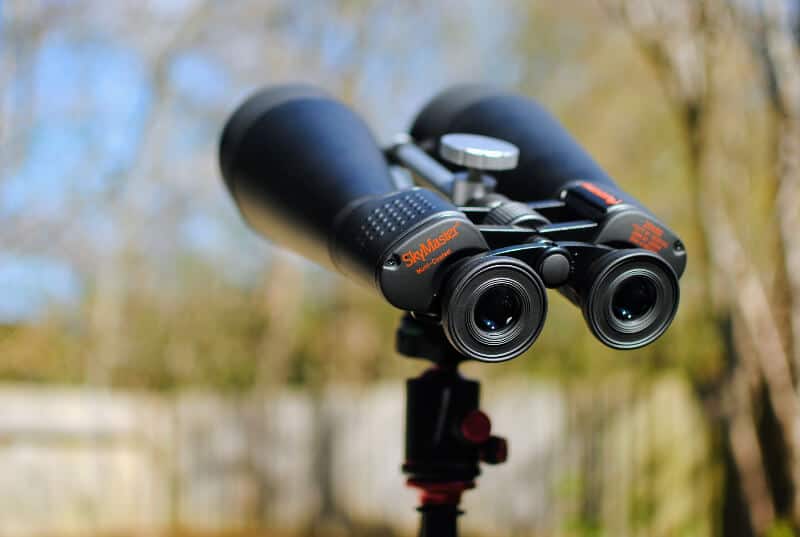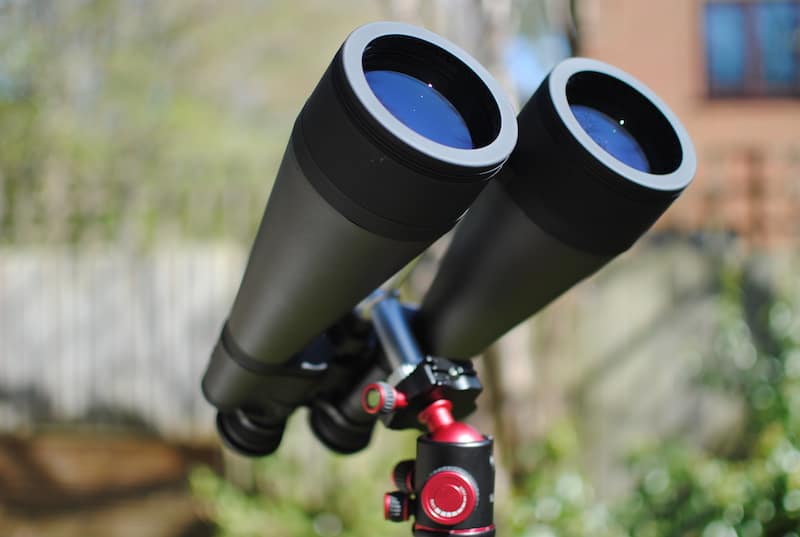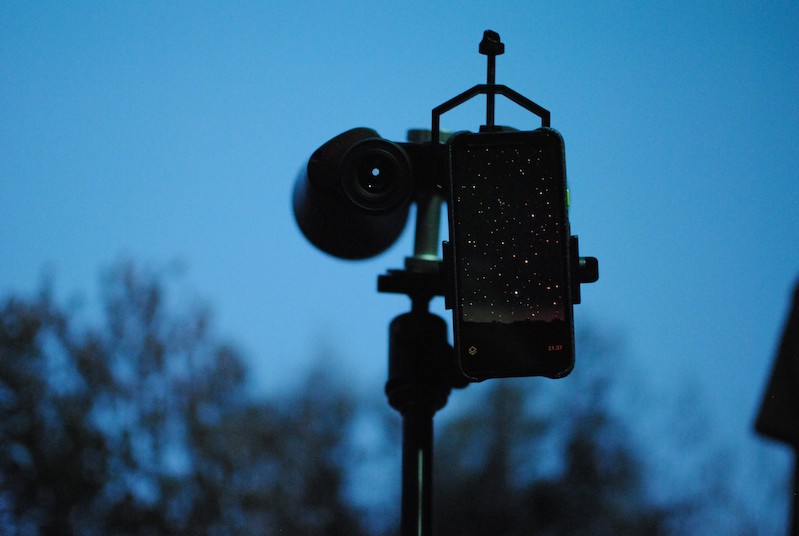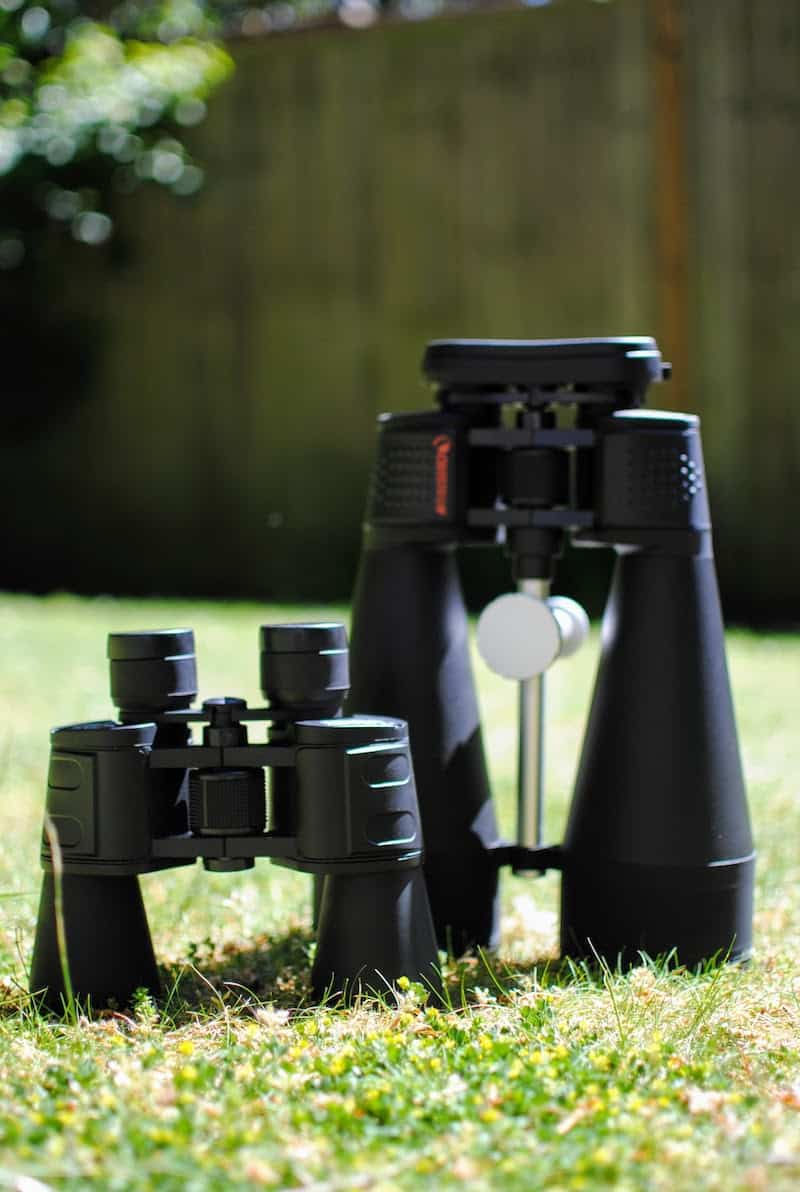Astronomy binoculars are a great alternative to telescopes.
They are generally smaller, easier to use, and cheaper. For those reasons, they are great for beginners and experienced astronomers alike.
In this article, we recommend the Best Astronomy Binoculars in 2025. Covering the best budget and beginner options, plus ultra wide-angle, and the most powerful models.
Here are our top picks:
— Best Overall: Celestron SkyMaster 20×80 Astronomy Binoculars
— Best Budget: Celestron Cometron 7×50 Binoculars
— Best Wide Field of View: Omegon 2×42 Ultra Wide Angle Binoculars
— Most Powerful: Celestron SkyMaster 25X100 Astronomy Binoculars
Read on for more detail, or watch our video below:
Best Astronomy Binoculars
Celestron SkyMaster 20×80 Binoculars
Best Binoculars for Stargazing

The Celestron SkyMaster 20×80 Binoculars are the best astronomy binoculars for most people.
They have the right balance of magnification and aperture for good views, whilst not being too heavy or expensive.
I have found these binoculars perfect for for quick setup and easy use on clear evenings and I’ve even had a go at smartphone astrophotography with them.
You can see my full hands-on Celestron SkyMaster 20×80 Binoculars Review if you want more depth. Or you can watch our video:
They can be used by hand for short sessions but to get the most out of them you will want to use them with a tripod – this is because the high magnification will result in a lot of visible shake when using by hand.
The tripod adapter is in-built so you don’t have to buy anything extra.
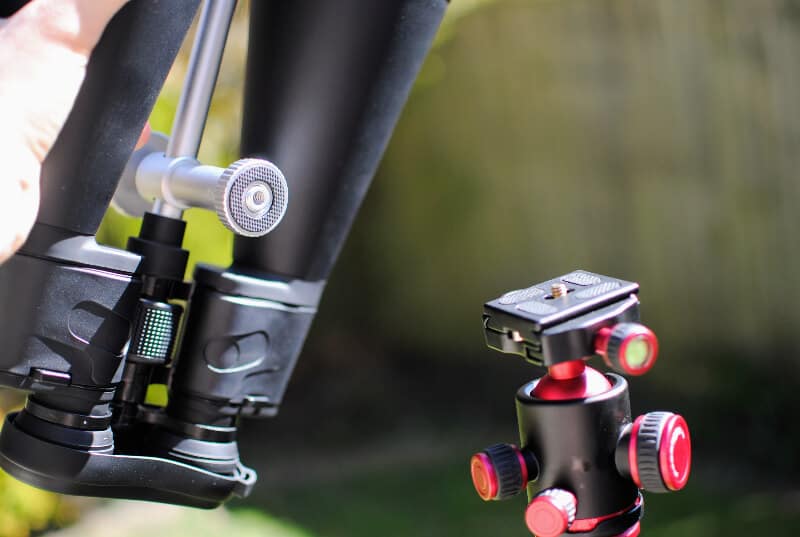
The plus side of the high (20x) magnification and large (80mm) aperture is that you will get clear, bright views of the moon, planets and even deep-sky objects in dark skies.
The trade-off from the below model (Cometron 7×50) is a narrower field of view – i.e. a smaller patch of the night sky in your eyepiece.
This is why smaller magnification is better for sky scanning or viewing events like meteor shows.
These higher magnification models can be used more like telescopes – finding and viewing specific objects in the sky.
You can use them for smartphone photography with one of Celestron’s adapters – the basic version or the premium NexYZ 3-Axis model.
These enable you to take photos with your phone’s camera through the binoculars:
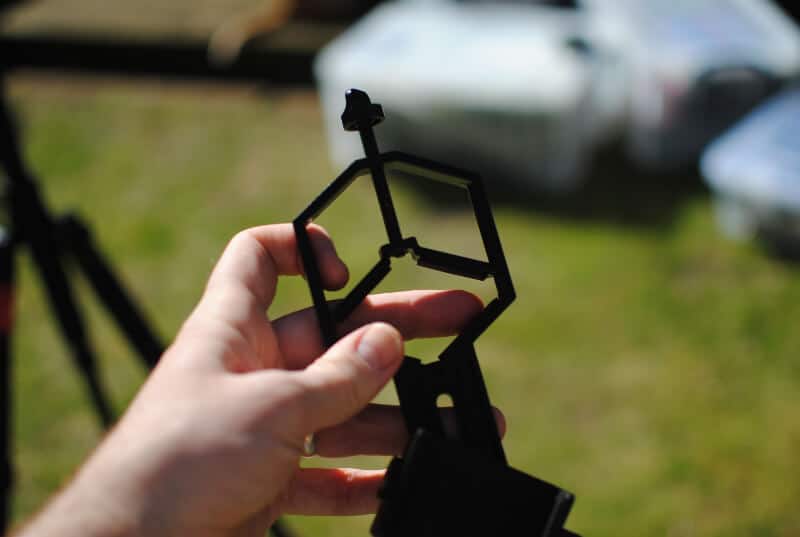
There are upgrade options to this model:
- Celestron SkyMaster 20×80 Pro – A slightly higher-quality build with improved lens coatings and weather-proofing
- Celestron SkyMaster 20×80 Pro ED – The same as the Pro but also featuring Extra-Low Dispersion (ED) glass lenses that reduces chromatic aberration (a visual defect common in binoculars)
If you have the budget, then these are better, but if you’re a beginner you’ll probably be unlikely to notice much difference.
Pros
- High magnification and large aperture for good astronomical viewing
- Good value, perfect balance of price and performance for most casual users
Cons
- There are always higher powered models with more aperture that will deliver better
- Need to be used with a tripod due to the high magnification (tripod adapter is attached)
Overall, these are perfect for most people looking for the best binoculars for stargazing. They are not too expensive but are powerful enough to provide serious views of astronomical objects.
Key specifications
- Aperture: 80mm
- Magnification: 20x
- Weight: 4.7lbs (2.1 kg)
- Field of view: 3.7 degrees
- Exit pupil: 4mm
- Eye relief: 18mm
Celestron SkyMaster Astronomy Binoculars
There are quite a few models and variations in the Skymaster binocular range from Celestron and so it’s worth having a quick overview of them all.
The original SkyMaster binoculars are available in a number of seven different models of varying magnification and aperture:
We recommend the 20×80 as providing a good balance of price to power.
You may prefer the higher aperture models 25×100 for better views, but these come at a higher price.
We do not recommend going for the lower magnification models like the 12×60 and 15×70 since they are still too high magnification to use by hand.
We also think the 20x80s are better than the closest alternative in the 25x70s as the higher aperture is worth more than higher magnification in terms of the views you can expect.
Skymaster Pro ED models
Lastly, there are two Skymaster Pro and three Pro ED models:
These models are very similar to the regular SkyMaster models but have improved glass coatings for clearer views, full weather-proofing, and the capacity to be used with a finderscope.
The ED models also feature Extra-Low Dispersion glass to reduce chromatic aberration.
They come at a higher price and so up to you as the buyer as to whether you think it is worth it.
Celestron Cometron 7×50 Binoculars
Best Budget Astronomy Binoculars

These stargazing binoculars are made by manufacturer Celestron, who are one of the leading manufacturers of telescopes and other high-quality astronomy equipment.
The 7x magnification is perfect for handheld use and for scanning the night sky.
Higher magnifications give you a narrower field of view and result in a much more visible shake when using by hand and need to be used with a tripod.
The 50mm aperture lenses will enable you to be able to see the moon in detail, some of the planets of our solar system, satellites and the International Space Station passing overhead, meteors and comets, and many more stars in the night sky.
Don’t expect too much though – these are best for scanning the sky, not close up views of specific objects.
These are light enough for most people to use just by hand and given the light weight and lower cost, these make great astronomy binoculars for beginners or kids, as well as for travel.
If you do want to use them with a tripod then you will need Celestron’s tripod adapter.
The upgrade pick to these are the Celestron SkyMaster Pro ED 7×50 Binoculars which are a higher-quality build and have better lenses.
Pros
- Small, light and portable
- Easy to use
- Suitable for handheld use
- Cheap
Cons
- Higher aperture models will give you brighter and clearer views
- Need to add an adapter to use with tripod
Key specifications
- Aperture: 50mm
- Magnification: 7x
- Weight: 2lbs
- Field of view: 6.8 degrees
- Exit pupil: 7mm
- Eye relief: 13mm
Beginner Astronomy Binoculars
- 7x magnification provides a wide field of view that reveals a larger portion of the night sky making them perfect for handheld use and viewing events like meteor showers
- Large 50 mm objective lenses have good light-gathering ability for astronomical use
- Multi-coated optics dramatically increase light transmission for brighter images with increased contrast and resolution
- Not optimized for targeted viewing of astronomical objects like planets and galaxies, where higher magnificatio and aperture will be better
Omegon 2×42 Ultra Wide Angle Binoculars
Ultra Wide-Angle Stargazing Binoculars
These stargazing binoculars from Omegon are ultra wide-angle and designed for enhancing your view when going out and observing constellations, meteor showers and starry skies in general.
These are quite different from the other models here in that they are very low magnification and extremely small.
They are fairly unusual looking in that they are Galilean build binoculars and resemble opera glasses.
They give you a 26-degree field of view which is huge compared to most regular stargazing binoculars.
The 42mm aperture is very large relative to the size of the actual binoculars and what you get is effectively a much brighter view of the night sky than you would get with your naked eyes.
Pros
- Extremely wide field of view for observing large patches of the sky
- Very small, light and portable
- Handheld use
Cons
- The specific low magnification nature of these means that you might want another pair of binoculars for getting closer to specific objects like the moon or planets.
Key specifications
- Aperture: 42mm
- Magnification: 2x
- Weight: 1.3 lbs
- Field of view: 26 degrees
Ultra wide-angle stargazing binoculars
- Extremely wide field of view for observing large patches of the sky
- Very small, light and portable for handheld use
- Bridges the gap between naked eye astronomy and narrower field large binocular astronomy
- Only for widefield stargazing, not zooming in on specific astronomical objects
Celestron SkyMaster 25×100 Binoculars
Most Powerful Binoculars for Astronomy
The Celestron SkyMaster 25×100 Binoculars are just about the most powerful astronomy binoculars that you can buy.
It has all the advantages listed above of being binoculars designed by Celestron for astronomy but with massive 100mm objective lenses.
This means that the images you see will be about as incredibly bright and detailed as you can get.
It’s hard to find astronomy binoculars with bigger than 100mm lenses unless you want to spend thousands of dollars on specialized models (see here for example).
These are water resistant so you can use it in damp conditions without worrying about damage. However, they’re not designed for permanent outdoor placement.
They weighs 8.6 pounds and does need to be used with a tripod.
Pros
- Huge 100mm objective lenses provide incredibly bright and detailed views of the night sky
- Easy to use for beginners
- In-built tripod adapter
Cons
- Need to be used with a tripod as they are relatively heavy and high magnification
Key specifications
- Aperture: 100mm
- Magnification: 25x
- Weight: 8.6lbs
- Field of view: 3 degrees
- Exit pupil: 4mm
- Eye relief: 15mm
High-Power Binoculars for Astronomy from Celestron
- 100mm aperture objective lenses to provide bright and detailed views of the night sky
- Easy to use for astronomy beginners
- In-built tripod adapter
- Need to be used with a tripod
What to look in Astronomy Binoculars
All binoculars are defined by two measurements that are usually listed in the name of the model. For example:
- Celestron Cometron 7 x 50 Binoculars
- Celestron SkyMaster 25 x 100 Binoculars
The first number always refers to the magnification and the second number always to the aperture.
So this Celestron Cometron model has 7x magnification and 50mm lenses (the aperture). The Celestron SkyMaster model has 25x magnification and 100mm lenses.
Knowing these numbers gives you a good indication of how the binoculars will be able to be used and what you’ll be able to see with them.
Let’s look at each of these things so that we can work out what we need.
Magnification
Magnification in binoculars refers to how many times closer the object you are viewing is.
So, 20×70 binoculars mean you will be viewing objects twenty times closer.
The temptation here is to assume that higher magnification will always be better, but that is not always the case:
- The pros of high magnification are that you are able to get much closer in to view far-off astronomical objects.
- The downside is that the higher the magnification the more unsteady the view is when using by hand. This means that higher magnification models will need to be used with a tripod to get the most from them or else it will be a frustrating experience. In WWII the US military limited binoculars to 7x magnification because higher than this was deemed useless for handheld use.
- The other downside is that you get a much narrower field of view – i.e. high magnification means you zoom in on a smaller patch of space and so is harder to scan the skies. This is especially important if you are out planning to view meteor showers or something like that.
In short, lower magnification models – 7 times magnification or less – are great for aiding your stargazing and scanning the skies by hand.
Higher magnification binoculars are better for being used more like you would a telescope – operating them with a tripod and zooming closer into specific objects.
You can also get zoom binoculars which enable you to increase or decrease the magnification. For example, a pair might be listed as 18-40×80, which would be 18x to 40x magnification adjustable by rotating a dial.
Aperture
Aperture refers to the light gathering capacity of the binoculars. This is important as you are going to the using them in low light and so a higher aperture is pretty much always better.
This is measured by the diameter of the binocular lenses in millimeters. So, 20×70 binoculars have 70mm diameter lenses and therefore 70mm aperture.
The only real downside to a larger aperture is the weight. The bigger the lenses, the heavier and bulkier the binoculars will be and so make them less operable by hand and less easy to travel with.
Other Specifications
There are a few other specifications that you’ll see listed with astronomy binoculars that are worth understanding:
- Porro Prism or Roof Prism: Porro Prism or Roof Prism refers to the type of binocular build and how the light is collected in the lens and directed to the eyepiece. All you really need is that pretty much all astronomy binoculars are porro prisms. This is because they are better at producing the bright images needed for stargazing in low light. Roof prism binoculars are more compact and better suited for daylight pursuits like birdwatching, etc.
- BAK-4 vs BK-7 prism glass: You may also see BAK-4 and BK-7 prism glass specified. This refers to a type of porro prism. BAK-4 prisms are the best and frequently used in astronomy binoculars.
- Prism coatings: The manufacturer will often list the quality of the prism or glass coating and how it impacts the clarity of the view. If you are buying a model from a respectable brand like those listed above they should all be good and aperture is a much better indicator of how clear the views will be.
- Waterproofing and fog proofing: This can obviously mean improved use in poorer weather. Whether or not that’s useful to you will depend on how and when you plan to use them.
- Exit pupil: This is a measurement calculated by aperture divided by magnification. So for 7 x 50 binoculars this will be 7.1mm. This is the diameter of the circle of light that you will view in the center of the eyepiece. The larger this is, the more light will be delivered to your eye and the better the views.
- Eye relief: This is a measurement that refers to how far away you can hold your eyes from the eyepieces when looking in. This is mostly important for glasses wearers as they will need to look for high eye relief.
- Tripod adapters: In-built tripod adapters for heaver models (to save you from having to use an additional component).
You’ll also want to check that any model comes with accessories like a carry case and things like smartphone or tripod adapters or else you might want to buy them separately.
How to use Astronomy Binoculars
When you first start astronomy with binoculars, there is a small number of adjustments that you will need to do to get them set up properly for your own eyes. All the models above include instructions that describe how to do it, and you can find more info online if you need it.
How you use them will also depend on what type you have. If you have a smaller hand-held pair (like the Celestron Cometron 7×50) then you will be freely using them to scan the sky. If you have a larger model (like all the others on this list), you will need to attach them to a tripod and you can then target specific objects in the night sky to see.
Free apps like Stellarium are great for working out what is in the sky above you any one night (see our article on the best apps to use).
Astrophotography with Binoculars
Astrophotography with binoculars can be done with an adapter to attach your smartphone to the eyepiece of the binoculars.
In this situation, you will need to be using the binoculars on a tripod to keep them steady when the image is being taken, especially since you may need to take a long exposure to get the picture.
Smartphone adapters for binoculars are available for sale and you can see our case study of using these with a pair of Celestron SkyMaster binoculars.
See also this video from AstroBiscuit where he successfully gets some amazing deep sky images using astronomy binoculars and a smartphone:
Best Astronomy Binoculars FAQs
Can you use regular binoculars for astronomy?
For stargazing, specialist astronomy binoculars are best.
The most popular regular binoculars are generally compact binoculars.
These are great for birdwatching and similar daytime pursuits but don’t have the light-gathering ability for dark skies and astronomy.
Binoculars vs Telescopes – what are best for stargazing?
Binoculars make a great alternative to telescopes in many ways. They are generally smaller, more portable, easier to use and cheaper.
Low magnification astronomy binoculars are perfect for helping you scan the skies and view events like meteor showers.
Higher magnification and higher aperture binoculars are very similar in telescopes in that they are best for observing specific objects and using them attached to a tripod. The advantage with binoculars is the simplicity and that you are using two eyes.
However, if you are chasing higher aperture and clearer views of far off objects then telescopes are generally better value, there are more options, you can use them with GOTO mounts and you can use them for astrophotography.
If you want to also consider telescopes, then check out our article on the best telescopes for beginners.
Binoculars vs Spotting Scopes for Astronomy?
Spotting scopes are compact telescopes primarily designed for daytime use and can be a good alternative to binoculars or telescopes.
For more detail on this topic, see Spotting Scopes vs Binoculars for Astronomy
Binoculars vs Spotting Scopes for Astronomy?
Spotting scopes are compact telescopes primarily designed for daytime use and can be a good alternative to binoculars or telescopes.
For more detail on this topic, see Spotting Scopes vs Binoculars for Astronomy
What can you see with astronomy binoculars?
A good, basic pair of astronomy binoculars on a clear night will enable you to see thousands of stars, the moon, and the planets of the solar system.
A premium pair of specialist astronomy binoculars should give you the capability to go beyond this and see deep sky objects (far-off galaxies and nebulae).
Do I need a tripod for astronomy binoculars?
To get the most out of heavier and high-magnification astronomy binoculars then you will need to use them with a tripod.
This is because you will be using them like a telescope – targeting objects in the night sky with the binoculars staying fixed in one place.
Celestron manufacture their own models – see our article on the Best Tripods for Binoculars.
Some binoculars have the adapter to fix them to a tripod built-in, but for others you may need to buy an adapter.
What are Giant Astronomy Binoculars?
“Giant” binoculars are defined as those that magnify the view 10 times or more and have 70mm or larger front (objective) lenses.
Verdict: Best Binoculars for Stargazing
Overall, the best astronomy binoculars for you will depend on your budget and what you want from them. We recommend:
- Best Overall: Celestron SkyMaster 20×80 Astronomy Binoculars
- Best Budget: Celestron Cometron 7×50 Binoculars
- Best Wide Field of View: Omegon 2×42 Ultra Wide Angle Binoculars
- Most Powerful: Most Powerful: Celestron SkyMaster 25X100 Astronomy Binoculars
You might well end up eventually getting a smaller, low magnification pair of astronomy binoculars for quick grab-and-go stargazing as well as a bigger pair to use with a tripod.
This is what I have ended up with (see picture below) and this complements my telescope by being much quicker and easier to set up, but I will still use my telescope for longer sessions or if planning to view something specific.


